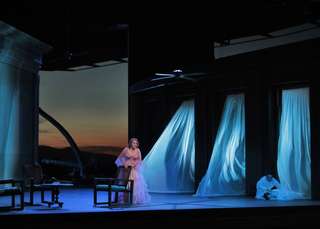|
Back
Moravec premiere plays it safe Santa Fe
The Santa Fe Opera House
07/25/2009 - & July 29, & August 3, 7, 15*, 18
Paul Moravec: The Letter
Patricia Racette (Leslie Crosbie), Anthony Michaels-Moore (Robert Crosbie), Roger Honeywell (Geoff Hammond), James Maddalena (Howard Joyce), Rodell Rosel (Ong Chi Seng), Keith Jameson (John Withers), Mika Shigematsu (Chinese Woman), Sung Eun Lee (head man), Andrew Stenson (guard), Jason Slayden (first clubman), Kevin Ray (second clubman), Lucas Harbour (a judge). Jonathen Kent (stage director), Hildegard Bechtler (scene designer), Tom Ford (costume designer), Duane Schuler (lighting designer). Susanne Sheston (chorus master), Patrick Summers (conductor). 
P. Racette & R. Honeywell (© Ken Howard)
Things have started to look up for new American opera over the last decade, as several successful world premieres have led to that most coveted prize among composers: a second production. The Santa Fe Opera wanted a piece of that pie, commissioning Pulitzer prize winner Paul Moravec and Wall Street Journal critic Terry Teachout to produce for their 2009 season the premiere of The Letter, an opera based on W. Somerset Maugham's 1927 play of the same name. The result: a standard if not groundbreaking work that at least has a shot at success.
Set in British Malaysia between the world wars, The Letter loosely follows the play and subsequent 1940 film of the same title. Brit Leslie Crosbie murders her lover Geoff Hammond after finding out he's taken a native as his other woman. After claiming to her husband that she killed Hammond only because he tried to rape her, Crosbie enlists her lawyer to buy off a letter she sent to Hammond before killing him - a letter which would incriminate Crosbie and is in the possession of the dead man's other lover. The lawyer succeeds and Crosbie is acquitted of murder charges. The opera takes liberties from the play and the film, but none that make the story unrecognizable.
The composer and librettist were quoted as saying that The Letter is "opéra noir." It really isn't. In fact, it's a work marked mostly by traditional structure (for better or for worse), both in the music and in the libretto. First, it's difficult to determine what librettist Terry Teachout aimed for in the structure of his text. During several sections of the opera, characters break out into aria mode at inopportune times; apart from slowing down the action, this device serves as a redundant tool in that we already know how the characters are feeling based not only on Moravec's score but the things they say before their arias. Secondly, the music itself remains tonal throughout the opera, blending 1940s style through-composed film score orchestration with long Romantic lines. Introspective arias follow intense scenes, arching strings rise during emotional outbursts, and expected keys correlate with expected emotions. It's not innovative and it's definitely not "noir." It does work in some places, and doesn't in others. The one outstanding scene of the opera came when Leslie Crosbie reenacted the murder of Geoff Hammond in a flashback. Moravec crafted for this duo an intense vocal and orchestral palate, as what could have been a shouting match became a tightly wound, thrilling five minutes of theater leading up to the shooting. During this encounter between Crosbie and Hammond, Moravec showed how well he can create anger and intensity for the voice without resorting to bluster or screaming. In Moravec's corner is the fact that he knows at least how to write for the voice, keeping inaudible vowels out of the highest registers and utilizing the larger and smaller voices together effectively.
Patricia Racette gave a solid performance as Leslie Crosbie, singing with the same piercing top that made Romantic heroines her trademark. Her characterization of the calculating, murderous wife was spot on, as she stayed appropriately calm during her prison scenes and throughout the rest of the opera. Tenor Roger Honeywell was outstanding as Racette's dead lover, Geoff Hammond. Honeywell's bright tenor rang throughout the house during what turned out to be the exceptional scene in the opera, his flashback encounter with Racette's character explaining what events led to his murder. Veteran Baritone James Maddalena created the role of Racette's lawyer Howard Joyce, presenting a thoughtful, poignant presentation out of what could have been a walk through. Anthony Michaels-Moore seemed to have a hard time reaching his upper register without shaking his entire body, but acted well and showed that his famed Verdi baritone fits other repertoire as well. Of the smaller roles, only character tenor Rodell Rosel stood out, portraying Maddalena's assistant with clarity of voice and a formidable stage presence.
Houston Grand Opera music director Patrick Summers sat at the helm of this opera. Summers, who was conducting his second consecutive world premiere (Read Marcus Karl Maroney's review of Brief Encounter), didn't seem particularly enraptured by the score, but he kept the sweeping lines of Moravec's orchestration in check and didn't let the Santa Fe Orchestra drown out any of the cast. Hildegard Bechtler's scenic design worked well for this seven scene, intermission-less opera as her sets flawlessly changed and elegantly morphed. Former Gucci hotshot Tom Ford made his theatrical debut in this production with period costumes that were fine but nothing more.
In the end, those looking for innovation will be disappointed in The Letter, as will those looking for a disaster. The Letter is a standard piece of music and theater that plays it safe and keeps the audience's attention. For Moravec's operatic debut, things could have been a lot worse.
Paul Wooley
|